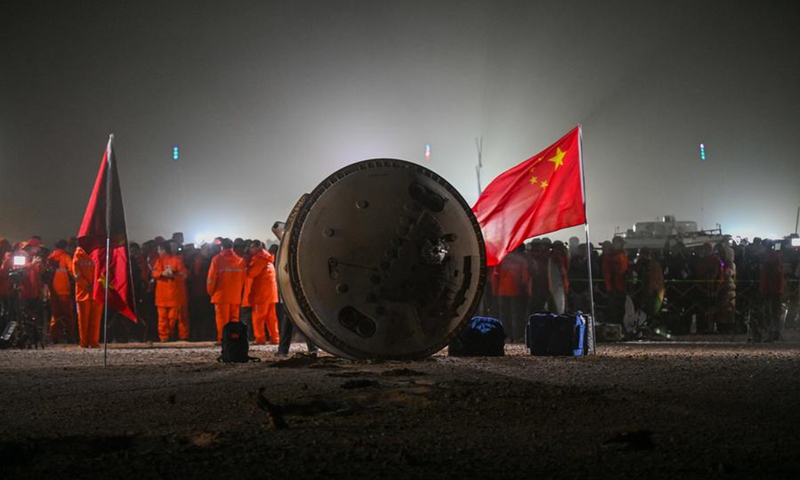
The return capsule of the Shenzhou-18 manned spaceship, carrying taikonauts Ye Guangfu, Li Cong and Li Guangsu, touches down at the Dongfeng landing site in North China's Inner Mongolia Autonomous Region, on November 4. Photo: Xinhua
The Shenzhou-18 spacecraft returned to Earth with 34.6 kilograms of experimental samples, including difficult-to-prepare microorganisms, alloy materials, and nanomaterials, the Science and Technology Daily reported on Monday. An expert told the Global Times that final analyses would be conducted by specialized ground teams to validate the data and propose new theories or technologies.
The retrieved samples are poised to advance the development of space fiber lasers, facilitate the creation of extraterrestrial materials, and explore the prospects of Earth life spreading through the cosmos, the Xinhua News Agency reported.
The Shenzhou-18's return capsule, carrying three Chinese taikonauts,
returned to Earth in the early morning on Monday, after completing a six-month space station mission.
The scientific experimental samples brought back by the spacecraft include a total of 55 types, spanning 28 science projects across areas such as space life sciences, space materials science, and microgravity combustion science.
The life science specimens comprise methane-generating archaea, radiation-resistant microbes and microorganisms that inhabit rocks, according to Xinhua. These are anticipated to lay the scientific groundwork for investigating the potential habitability of extraterrestrial environments and to assess the capacity of microorganisms to adapt to the challenges of outer space.
Part of the returned samples are high-temperature resistant alloys, fiber optics and optical coatings. These innovative materials hold the potential to revolutionize the manufacturing of next-generation aerospace turbine blades, space-adapted fiber lasers, and precision medical repairs, according to Xinhua.
The spacecraft also returned nanoparticles derived from methane combustion, which are intended to facilitate the future synthesis of critical particulate materials for extraterrestrial environments.
The process of space experiments can be divided into two main parts: One part involves conducting experiments on the space station, while the other entails data analysis and summary evaluation on the ground, Wang Yanan, chief editor of Beijing-based Aerospace Knowledge magazine, told the Global Times on Monday
On the space station, researchers record the experimental processes and data, but the final analyses and conclusions rely on the work of specialized teams on the ground. These teams encompass fields such as zoology, botany, medicine, and life sciences, and are responsible for validating the data and proposing new theories or technologies, Wang said.
Additionally, certain experimental samples, such as those from exposure experiments in space, may require further physicochemical analyses on the ground, as the environmental conditions on the space station limit certain types of analyses. Therefore, both the experimental data and samples ultimately need to be returned to Earth for comprehensive evaluation and research, he added.




